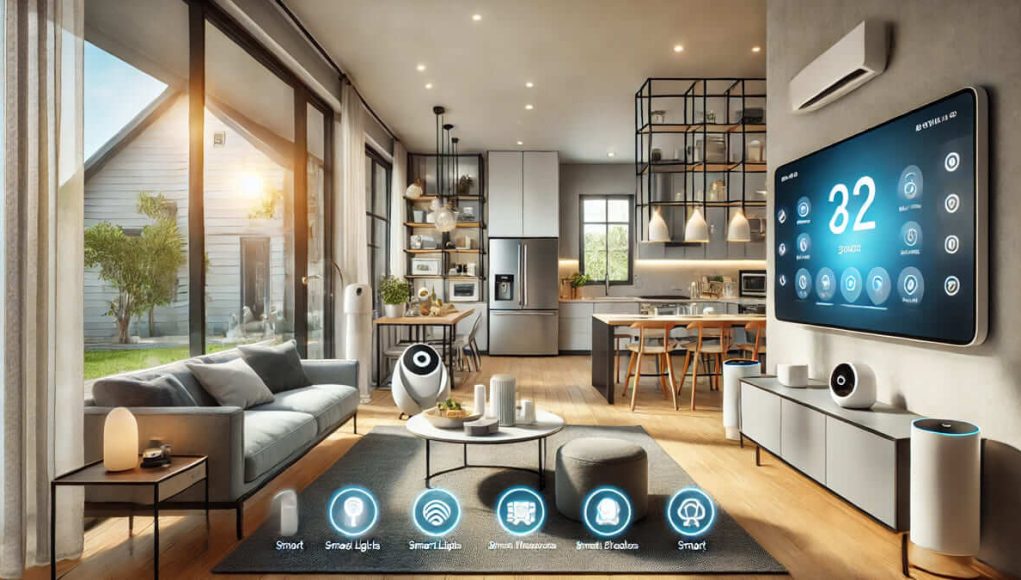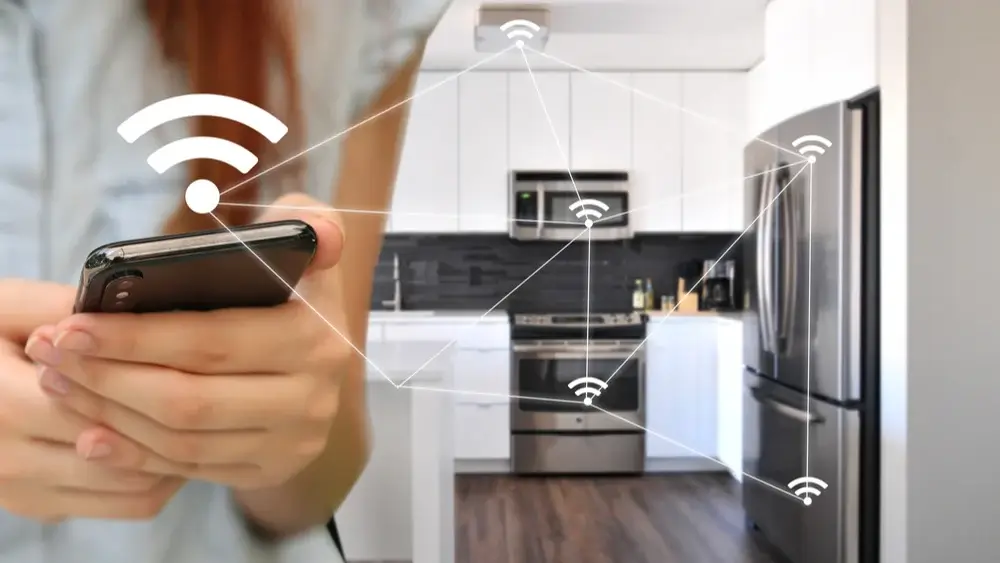Smart home technologies are revolutionizing the way we interact with our homes. From controlling lights with voice commands to automating security systems, these technologies provide homeowners with convenience, energy efficiency, and increased home security. Integrating smart home automation systems into home improvement projects is becoming increasingly popular as more homeowners seek ways to enhance the functionality and efficiency of their homes.
In this article, we will explore various smart home devices and automation systems, focusing on how they can improve energy efficiency, home security, and overall home functionality.
Table of Contents
- The Benefits of Smart Home Technologies
- Key Smart Home Devices to Consider
- The Role of Energy Efficiency in Smart Homes
- Voice Control and Smart Home Integration
- Connected Appliances for a Smarter Home
- Conclusion
1. The Benefits of Smart Home Technologies.
Smart home technologies offer numerous benefits that can improve homeowners’ quality of life while also increasing property value. These technologies provide convenience, energy savings, and enhanced security, making daily tasks more manageable and homes more sustainable.
Key Benefits of Smart Home Technologies:
- Increased Convenience: Control various devices and systems from a smartphone, tablet, or voice assistant.
- Energy Efficiency: Optimize energy use with automated lighting, heating, and cooling systems.
- Enhanced Security: Monitor and control security cameras, door locks, and alarm systems remotely.
- Customization: Tailor home automation systems to meet your specific needs and preferences.
- Long-term Savings: Reduce energy costs and maintenance expenses through automation.
2. Key Smart Home Devices to Consider
Smart home technologies include many devices that can be integrated into home improvement projects. These devices can be installed individually or as part of a larger home automation system, depending on your needs and budget.
a. Smart Thermostats
One of the most popular and beneficial smart home devices is the smart thermostat. A smart thermostat allows homeowners to control their heating and cooling systems remotely via a smartphone app or voice assistant. These thermostats learn your schedule and preferences and adjust the temperature automatically to optimize comfort and energy efficiency.
Key Benefits of Smart Thermostats:
- Energy Savings: Smart thermostats can reduce heating and cooling costs by learning your daily routine and adjusting the temperature accordingly.
- Remote Control: Manage your home’s climate from anywhere using a smartphone app.
- Voice Control: Many smart thermostats are compatible with voice assistants, allowing you to adjust the temperature with simple voice commands.
- Energy Reports: Some smart thermostats provide detailed reports on your energy usage, helping you identify areas for improvement.
Popular smart thermostat brands include Nest, Ecobee, and Honeywell.
b. Automated Lighting Systems
Automated lighting is another key feature of a smart home. With automated lighting systems, homeowners can control their lights remotely, set schedules, and even adjust the brightness based on natural light levels. These systems are perfect for enhancing both energy efficiency and home security.
Key Benefits of Automated Lighting Systems:
- Energy Efficiency: Automated lighting reduces energy waste by turning lights off when they’re not needed or adjusting them based on the time of day.
- Home Security: Automated lighting can be used to make your home look occupied when you’re away, deterring potential intruders.
- Voice Control: Many automated lighting systems can be controlled via voice assistants like Amazon Alexa or Google Assistant.
- Mood Lighting: Create different lighting scenes for various activities, such as reading, entertaining, or relaxing.
Popular brands for automated lighting include Philips Hue, Lutron Caseta, and Sylvania Smart+.
c. Home Security Systems
Home security systems are an integral part of any smart home. These systems offer peace of mind by allowing homeowners to monitor their property in real time, receive alerts about unusual activity, and control door locks, cameras, and alarms remotely.
Key Features of Smart Home Security Systems:
- Remote Monitoring: View live video feeds from security cameras through your smartphone.
- Smart Door Locks: Lock and unlock doors remotely, or grant temporary access to guests or service providers.
- Motion Detection: Receive alerts when motion is detected in or around your home.
- Integration with Other Smart Devices: Many security systems integrate with other smart home devices, such as automated lighting and thermostats, for added convenience and control.
Popular smart home security brands include Ring, ADT, and SimpliSafe.
3. The Role of Energy Efficiency in Smart Homes
One of the primary reasons homeowners invest in smart home technologies is to improve energy efficiency. Smart devices, such as thermostats, lighting systems, and connected appliances, can optimize energy usage, leading to significant cost savings over time.
How Smart Home Devices Improve Energy Efficiency:
- Smart Thermostats: Automatically adjust heating and cooling based on occupancy and preferences, reducing energy waste.
- Automated Lighting: Sensors and timers ensure lights are only on when needed, reducing electricity consumption.
- Energy Monitoring: Some smart home systems provide detailed energy usage reports, allowing homeowners to track their consumption and make informed decisions about where to cut back.
By incorporating smart home technologies into your home improvement projects, you can reduce your carbon footprint and enjoy lower energy bills.
4. Voice Control and Smart Home Integration
Voice control is one of the most convenient features of smart home technologies. With voice-activated devices like Amazon Alexa, Google Assistant, and Apple Siri, homeowners can control various aspects of their homes simply by speaking. Whether it’s adjusting the thermostat, turning off the lights, or locking the front door, voice control adds a layer of convenience and accessibility.
How to Integrate Voice Control into Your Smart Home:
- Choose a Compatible Voice Assistant: Most smart home devices are compatible with popular voice assistants like Amazon Alexa, Google Assistant, or Apple Siri.
- Sync Devices to the Voice Assistant: Once you have a voice assistant, sync your smart home devices to it through the device’s respective app.
- Use Simple Voice Commands: Set up basic voice commands to control your devices. For example, “Alexa, set the thermostat to 72 degrees” or “Google, turn off the kitchen lights.”
- Group Devices Together: Create groups of devices for more convenient control. For example, you can create a “bedtime” routine that turns off all lights, locks the doors, and adjusts the thermostat.
5. Connected Appliances for a Smarter Home
Another essential component of smart home integration is connected appliances. These appliances can be controlled remotely, providing both convenience and energy efficiency.
Popular Connected Appliances:
- Smart Refrigerators: Monitor your fridge’s contents, create grocery lists, and even receive notifications when food is about to expire.
- Smart Ovens: Preheat your oven remotely, adjust cooking times, and monitor your meal’s progress from your smartphone.
- Smart Washers and Dryers: Start or stop laundry cycles from anywhere, and receive notifications when laundry is complete.
- Smart Dishwashers: Control your dishwasher remotely and receive maintenance alerts to keep it running efficiently.
Popular Connected Appliances:
- Smart Refrigerators: Monitor your fridge’s contents, create grocery lists, and even receive notifications when food is about to expire.
- Smart Ovens: Preheat your oven remotely, adjust cooking times, and monitor your meal’s progress from your smartphone.
- Smart Washers and Dryers: Start or stop laundry cycles from anywhere, and receive notifications when laundry is complete.
- Smart Dishwashers: Control your dishwasher remotely and receive maintenance alerts to keep it running efficiently.
How Connected Appliances Improve Home Life:
- Convenience: Manage your appliances from anywhere, whether you’re at home or on the go.
- Energy Efficiency: Many connected appliances are designed to optimize energy use, saving you money on utility bills.
- Maintenance Alerts: Receive notifications when maintenance is required, preventing costly repairs.
6. Conclusion
Integrating smart home technologies into your home improvement projects is a wise investment that enhances both the functionality and value of your property. From smart thermostats that optimize energy usage to automated lighting systems that add convenience and security, these technologies make everyday tasks easier while reducing energy consumption.
Whether you’re looking to improve home security, enhance energy efficiency, or simply enjoy the convenience of voice control and connected appliances, smart home devices offer a wide range of benefits for homeowners. By taking advantage of the latest advancements in home automation, you can create a more efficient, secure, and comfortable living environment for you and your family.
Incorporating these smart technologies into your home improvement projects will not only improve your quality of life but also add significant value to your property.







